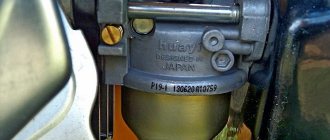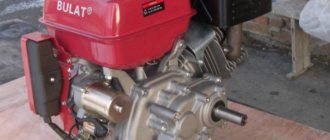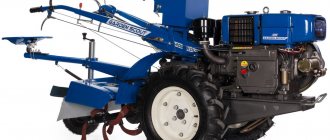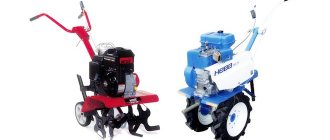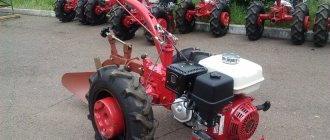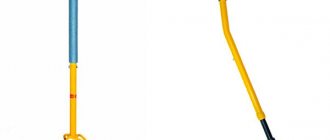Mole is the name of a series of walk-behind tractors from the domestic company of the same name, known since the 1980s. The company began its activities with the production of compact and lightweight models for a narrow range of works. The first version of the walk-behind tractor of the same name was unsuccessful, and the manufacturer began to modernize it. Today, the Mole walk-behind tractor has been adapted to modern standards, although it is still based on a time-tested design. Large-scale updates have been beneficial, and owners have begun to complain less about shortcomings associated, for example, with a lack of productivity.
Purpose and design features
The Mole is an old-timer on the domestic market among the universal cultivators. It is very compact and looks unusual compared to the usual agricultural machinery. But despite its small size, the Mole is capable of performing a wide range of tasks related to weeding, loosening, harrowing, leveling, digging, etc. The maximum area of the processed surface for which the Mole is designed is within 0.1 hectares. The capabilities of the equipment can be expanded with attachments. It is commendable that the basic version already includes a coulter and a cutter. Naturally, for an additional fee, the manufacturer has provided more functional equipment with which the walk-behind tractor can be used for digging and planting root crops. The most complete versions boast six cutters. Each modification has the ability to adjust the loosening length depending on the length of the opener used. In the front part of the walk-behind tractor there are mounts for installing MNU-2 equipment for pumping water.
The Mole is not able to work in autonomous mode, as it has completely manual control. Moreover, the operator must constantly adjust the steering wheel to prevent the walk-behind tractor from lifting up or getting stuck in place. You can also improve maneuverability by adjusting the depth using the handle. To do this, the equipment must be raised or, conversely, pressed well into the ground for better stability.
The Mole walk-behind tractor has proven itself well in gardening and is also in demand among summer residents. Let us highlight the main advantages of the model:
- outstanding performance parameters
- high performance despite the compact body and low-power engine
- a chain gearbox with a high degree of reliability is available
- The walk-behind tractor is easy to maneuver due to its compact design
- Horizontal and vertical adjustment possible
Please note that Mole has several modifications. Thus, the last of them is considered the most technically advanced, and can be used for processing heavy soil and even virgin soil.
It is worth noting that there are two models on the market - Mole 1 and Mole 2. It is logical that the second option is improved and more functional. The walk-behind tractor has a reverse gear, which allows it to turn 360 degrees. Also worthy of special attention is the updated carburetor, centrifugal regulator (the crankshaft rotates with it), as well as a more efficient air filter.
To store a walk-behind tractor, it is not necessary to have a large area, since the machine can be placed anywhere - largely due to its compact size. For example, the device will fit into the trunk without any problems. There are no complaints about the ergonomics of the driver's seat - all the instruments impress with their ergonomic design and rational arrangement of control components.
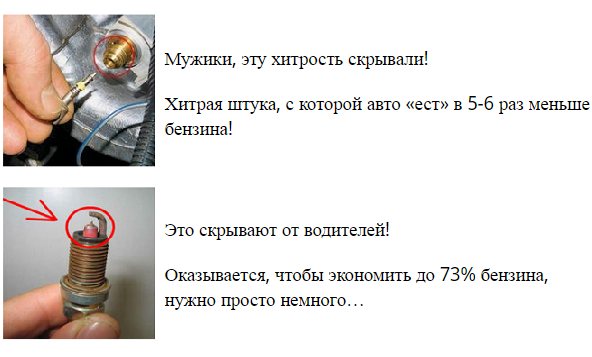
Description of walk-behind tractors
Technological progress does not stand still, and agriculture is no exception. Rakes, shovels, hoes and other hand tools are being replaced by motorized equipment, which can greatly facilitate heavy excavation and other agricultural work. And it is not necessary to buy a separate machine for each type of work. It is enough to purchase one multifunctional device that can replace the entire set of garden tools.
Walk-behind tractors are just such machines. These universal technical means are capable of plowing, loosening, chopping and covering weeds, hilling, harrowing, making hay and even applying fertilizers.
A walk-behind tractor is an improved motor-cultivator with more advanced capabilities and options. The versatility of the walk-behind tractor is achieved by a design where the engine is a separate module with wheels on which you can attach various additional equipment, such as a milling cutter, a plow, a hiller, a snow blade and even a cart with a seat. For the Russian consumer, the Mole walk-behind tractor is simply a godsend. Over the entire period of its existence on the market of small agricultural machinery, Mole walk-behind tractors have been characterized by reliability and durability. I would like to note that all work with mechanisms can be done without much physical effort. For example, when plowing, the device practically moves forward by itself, tearing and turning over layers of soil.
Back in 1983, Soviet engineers developed the first models of Krot walk-behind tractors. Very quickly these cars won the love of Russians. The production of these devices, only in more modernized versions, is carried out to this day by factories in Moscow and Omsk.
Characteristics and engine
The Mole walk-behind tractor is designed for a processing depth of up to 250 mm, and the maximum processing width reaches 600 mm. During milling, the available capacity is 200 sq. m. per hour. The weight of the device is only 68 kg, which allows you to apply a minimum of effort to the equipment for its careful operation.
The equipment has a body length of 1300 mm, and the width and height are 550 and 1100 mm, respectively. The fuel tank capacity is 3.6 liters.
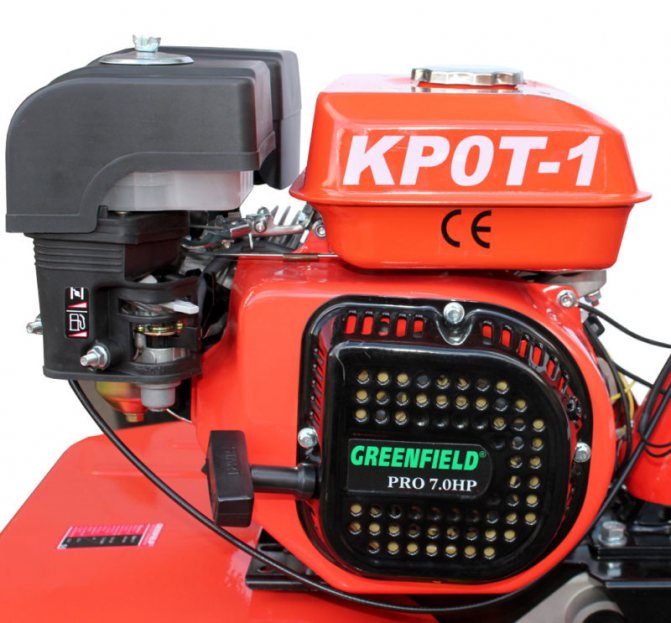
A 4-stroke power plant produced abroad is responsible for the performance of the Mole walk-behind tractor. We are talking about a 1-cylinder GreenField GX engine with an overhead valve design. We also note the piston group with a liner made of cast iron material. To start the engine, you must spin the recoil starter properly.
With a working volume of 0.2 liters, the GreenField GX engine develops about 6.5 horsepower and has a rotation speed of 400 operating hours. There is support for domestic gasoline not lower than AI-80. Oil is used only from recommended brands. In addition, as an alternative, a version with a less powerful 2-stroke engine of domestic production is offered. Its service life is relatively short by modern standards, and does not exceed 4000 operating hours.
Design
The design of this model is so primitive that some craftsmen are trying to assemble a Mole cultivator with their own hands. The frame consists of two half-frames bolted to the gearbox. At the rear of the walk-behind tractor there are tubular control handles and a platform for installing attachments. Engine and clutch speed controls are located on the handles.
Soil steel cutters are fixed on the output shafts of the gearbox. There are four of them in the basic versions, but there are options that work with six cutters. Their diameter is 320 mm, which allows you to cut through the ground to a depth of 25 cm. Considering the main purpose of this walk-behind tractor, this size is quite justified. The cultivator does an excellent job of plowing and removing small weeds.
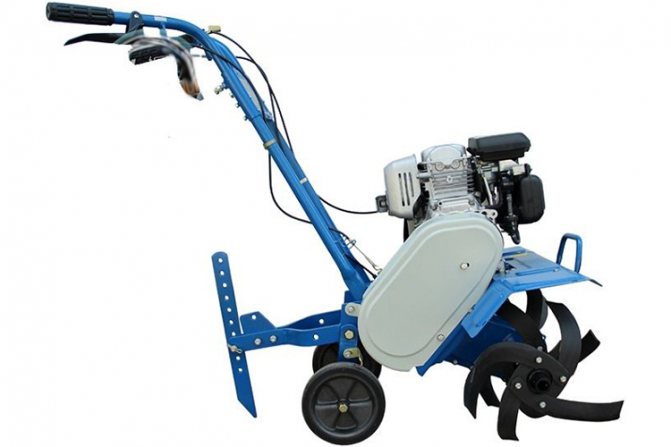
The internal combustion engine is mounted on the frame of the Mole cultivator and connected to the input shaft of the gearbox via a V-belt transmission. The engine of the basic modifications of this agricultural machinery is the simplest - a single-cylinder two-stroke with an air cooling system. It is equipped with a dry air filter and a non-removable manual cable starter. “Mole” runs on gasoline or diesel. Engineers placed the fuel tank on top.
Improved versions are equipped with imported two- and four-stroke engines, which increases the endurance of the equipment when processing difficult soils. The model range includes devices with electric motors, which are in demand when processing closed greenhouses.

Regardless of the option, “Mole” is equipped with five oil seals that guarantee tight connections. This is one of the preventative measures for an engine that stops working if the seal is broken as a result of loosening.
Run-in
Running in before first use is an important procedure for any walk-behind tractor. Therefore, in the case of the Mole, running-in is the primary task before full operation. This process lasts about 8 hours. Initially and after break-in, it is necessary to check the level of working fluids and, if necessary, add oil and fuel. Please note that the first stage of running-in is to check the performance of the engine, as well as other components and assemblies. In particular, you need to pay attention to how well the gearbox operates. You may have to adapt to it. Another important point is that the walk-behind tractor is usually operated under a 50% load during the break-in period. Later the Mole will be ready for full use.
Prices in Russia
Currently, the Mole walk-behind tractor continues to be produced. This model remains in steady demand, largely due to its low price, compact dimensions and high functionality. Thus, the recommended price of a new walk-behind tractor on the Russian market is 17 thousand rubles for the basic configuration. The most complete version will cost 30 thousand rubles.
Due to the fact that Mole has been on the market for quite a long time, it can often be found on the supported market. As an example, consider a six-year-old example with additional options and various other equipment. The price of such a product will reach a maximum of 15 thousand rubles.
Motoblocks Krot 1 and Krot 2 successfully compete with domestic and foreign models. Thus, among the machine’s analogues one can highlight the Neva MK-200, as well as the Patriot 7.0/600 FB PG.
Using the Mole cultivator
Owners of summer cottages, vegetable gardens, and such residents of rural areas certainly appreciated such time-tested agricultural equipment as the “Mole” motor-cultivator.
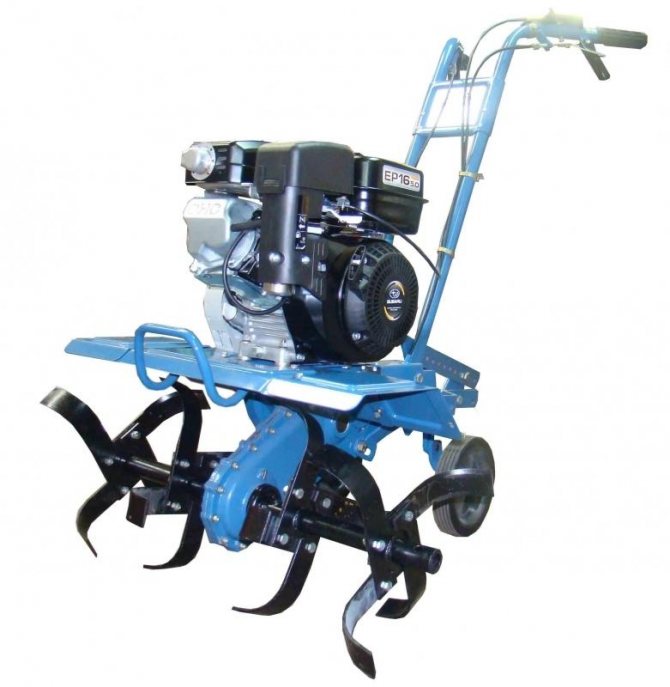
Who is its manufacturer? This technique was born in the distant 80s in the Soviet Union on aviation. The manufacturer of the “Mole” cultivator gave everyone who engages in agriculture for personal needs a real mini-harvester.
The Mole motor cultivator can perform almost any agricultural work:
- plowing of soils, including virgin soils;
- planting potatoes;
- hilling of plants;
- weeding;
- potato harvest;
- snow removal in winter;
- grass cutting;
- transportation of harvested crops from one destination to another.
Description
Walk-behind tractors are used by rural residents for cultivating soil and transporting goods. Relatively recently, Chinese Krotof walk-behind tractors appeared on the market. These devices have a low price in their market segment, since the company is relatively young and is trying to gain its customers.
Krotof walk-behind tractors are available in both petrol and diesel versions.
Krotof WG251
This Krotof walk-behind tractor is equipped with a gasoline single-cylinder four-stroke engine YL170F/P with a power of 7 horsepower.
- The maximum processing width of the cutters is 105 cm, and their immersion depth is adjustable from 18 to 39 cm.
- The average speed of movement of the Krotoff walk-behind tractor is 0.27-0.45 meters per second.
- This model is equipped with pneumatic tires with size 4.00-8.
- The Krotoff VG251 walk-behind tractor weighs 85 kg.
User manual
Tilling the soil
The main purpose of any of the presented “Mole” motor cultivators is to plow the soil. For this purpose, durable cutters with a diameter of 33 cm can be used, or a mounted reversible plow attached to the cultivator at the rear using a special hitch. In the first case, plowing occurs thanks to moving cutters that are mounted on the gearbox shaft.
Hilling
When it is necessary to hill up the beds, a special device is used - a hiller. In this case, the cutters are removed, and wheels with metal lugs are installed in their place. A hiller is attached to the back of the “Mole” (remove the coulter).
Weeding
Special devices will help in the fight against weeds - weeders, which are put on cutters instead of removable knives. If you attach a coulter to the back of the cultivator, then in addition to weeding, hilling will also be done.
Planting potatoes
Planting potatoes and subsequent harvesting is a labor-intensive task for those gardeners who did not have time to purchase a “Mole” motor-cultivator of any model. In addition to the unit itself, you will need special trailed equipment - a potato planter and a potato digger. Having tried these devices at work just once, you will forever forget about back pain and incredible fatigue during planting and harvesting potatoes.
Mowing
Mowing lawns, lawns and pastures using the same unit will be carried out using a mower attached to the front of the unit. All you need to do is attach the pneumatic wheels to the gearbox shaft, put belts on the pulleys of the mower and motor-cultivator.
Liquid pumping
To pump liquid, a mobile pumping station is used, which is also attached to the cultivator. Thanks to the V-belt drive, the unit is connected to the “Mole” engine, and do not forget to remove the V-belt drive from the gearbox.
Technical features of the equipment
The device has a light weight - from 48 kilograms and an approximate size - 130x81x106 centimeters. The unit does not take up much usable space, which allows it to be stored in a garage, small workshop or transported by car. The design of the Russian manufacturer consists of a simple scheme - aluminum tubular handles are welded to the frame, on which equipment control elements are located.
The frame itself is installed using bolts directly to the gearbox attached to the engine. A cutter is mounted on the cultivator to the “output area”. For convenient transportation, wheels are installed on the frame, but they must be removed during soil cultivation.
The engine for a cultivator is often used in a single-cylinder or double-cylinder type with forced air cooling. The power of this element is from 2.6 horsepower, the working volume does not exceed 60 cm3. The engine for the cultivator is started manually, using a special rope.
There are also two gears - forward and reverse on the cultivator, making it easier to control. Mills for plowing the soil are made of hardened steel and have sharp tips.
The cutters have good resistance to aggressive environments, which increases the service life of the equipment.
VIDEO: How to work with a cultivator for beginners
Methods of application and additional elements
The device has a wide range of applications. To increase the number of possibilities, you will need to buy additional spare parts for the cultivator. Using the equipment you can produce:
- Plowing the land
It is necessary to install tillers on the output shafts and lift the wheels intended for transportation. The coulter, mounted directly on the bracket, acts as a brake and regulates the intensity of tillage. In this work, the main functioning element is cutters.
- Weeding
Here you will need an instruction manual, since it is necessary to attach “L”-shaped weeding blades to the internal cutters, after first removing the plowing knives.
- Hilling and preliminary soil preparation
The tillers are dismantled and wheels with lugs (made of metal) are installed. This item is not included in the kit and must be purchased separately. In place of the coulter, a hiller is installed.
- Digging up potatoes
A unit with metal wheels can be equipped with a potato digger, which is not included in the package.
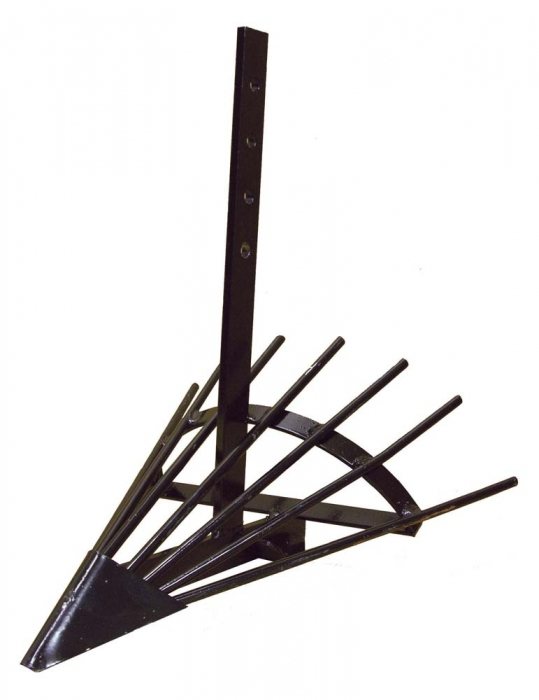
Potato digger for cultivator sold separately, easily connected to the main frame
- Cargo transportation
Instead of metal cutters, it is necessary to install rubber wheels and attach a trolley to the frame.
- Pumping water
The V-belt on the traction gearbox must be removed and then connected to the pumping system and engine.
- Mowing the grass
The design of the unit allows it to be additionally equipped with a haymower, which can be purchased separately. The element is connected to the V-belt drive motor.
Rating of the best models of Mole cultivators
Initially, the equipment was produced in the form of one model - the Krot MK1 milling type cultivator. Over the years, the manufacturer has improved the equipment with additional spare parts that increase its functionality, resulting in several series.
Mole MK
MOLE MK-9-02 HAMMERMANN
Models of the MK series have the most compact dimensions and low power. Due to the ease of storage, the possibility of transportation and affordable cost, they are considered one of the popular modifications.
Mole DDE
DDE V 750 II Mole 2
Consists of three models: cultivator Mole 2, 1 and V700II. The first modification is equipped with two gears, rear and forward, the second is air-cooled and has a plate against soil scattering, the last is equipped with an engine of the company’s own production.
Maintenance
Properly organized and carried out maintenance of a cultivator can extend its life and performance for many years. There are several operations that return the unit to normal operation:
- washing and cleaning the motor cultivator;
- inspection and technical inspection;
- lubricant;
- adjustment.
Important! All these actions must be performed regularly, immediately after using “Mole”. Then its service life will definitely exceed the stated 40 years.
The latest Krot models are equipped with imported two- and four-stroke engines. The following brands can be distinguished:
Follow simple maintenance rules:
- as fuel it is necessary to use gasoline (A-76, A-96) in a ratio of 20/1 with autol (motor oil M-8B);
- monitor the amount of oil and add it on time;
- M-8B oil (Avtol) can be replaced with other brands, for example 10W-30 or SAE 30.
- After carrying out work involving the cultivator, it is necessary to thoroughly clean and lubricate its parts with oil and lubricant, drain the remaining fuel and remove the unit.
When choosing a small amount of M-8B, remember that you can work with this oil at temperatures up to 27 degrees; higher temperatures are not recommended due to excessive consumption. Other recommended options are not used if the air temperature is below 4 degrees;
Cultivators Mole
The production of Mole cultivators began in Soviet times in 1983, and they were produced at machine-building plants in Moscow and Omsk. Currently, this is being done by OJSC MPP im. V.V. Chernyshev", which is also located in Moscow.
Purpose
In order to properly plow a summer cottage, you need to spend a lot of time and effort. And to avoid this, it is enough to purchase a Mole cultivator for your dacha, which will qualitatively cultivate the soil, loosen it and saturate it with oxygen. The milling depth reaches 25 mm. The blades of the cultivator cut off the top layer of soil, crush it, and then mix it. At the same time, it is quite easy to manage.
Advantages and disadvantages
Mole cultivators have the following advantages:
- The Mole cultivator is quite compact, making it easy to clean, maintain, store and transport;
- Quite simple controls that even a child can master;
- Looses and plows the soil efficiently and quickly;
- No serious physical effort is required during processing.
The use of additional equipment allows you to significantly expand the scope of application, from a conventional ripper to a pump;
There are also several disadvantages:
- It is best suited for processing small areas, since when working with a large area it is ineffective and can overheat.
- The belt drive may be a weak point.
Owner reviews
Vladimir, 42 years old
“Having bought the Mole, I immediately put it to work. At first I was very upset, because the virgin soil did not give way, “Mole” clearly could not cope with its task. But having turned to a friend for advice, I realized that you can’t take such soils in the heat of the moment; you must first break in the engine, prepare it for such loads. Then I learned that it is better to plow such land in several stages, cutting deeper and deeper each time. Things went well. Over the past 7 years (from the date of purchase) I have purchased everything necessary for planting and digging potatoes, and last year I acquired a cart. I haven’t used it as a hay mower, there’s no need for it. So now I don’t regret the purchase.”
Andrey, 28 years old
“I bought Krot in 2014. At first, I spent a long time choosing, studied all the weak and strong points and decided to settle on the MK-5-01 cultivator with a Honda engine. Works stably without a break! I can freely take 10 acres at a time. I strengthened the frame a little last year, I try to keep it clean - problems with ignition, etc. I don’t care about! Over the three years of operation, “Mole” has earned its value many times over!”
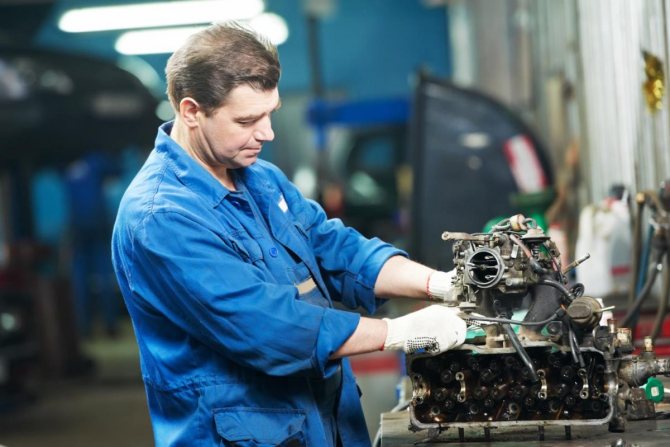
Auto mechanic, specializes in agricultural equipment
A motor cultivator is a tool for cultivating the soil with cutters and is equipped with a set of mounted implements (for controlling weeds and applying fertilizer to the ground). The main difference from a walk-behind tractor is its compactness, and this unit does not have a power take-off shaft (PTO). The motor cultivator also has a chain gearbox and cultivation cutters that replace wheels. This makes it cheaper and adds another plus to everything said above.
This mini-tractor, if equipped with additional parts, can perform a whole range of actions: digging, hilling, digging and plowing, as well as removing garbage and snow, being an excellent helper in the garden (uprooting root crops, digging in hard-to-reach places), mowing grass. The only negative difference between a motor cultivator and a walk-behind tractor is that the second one has a trailed trolley, which can be very useful on the farm.
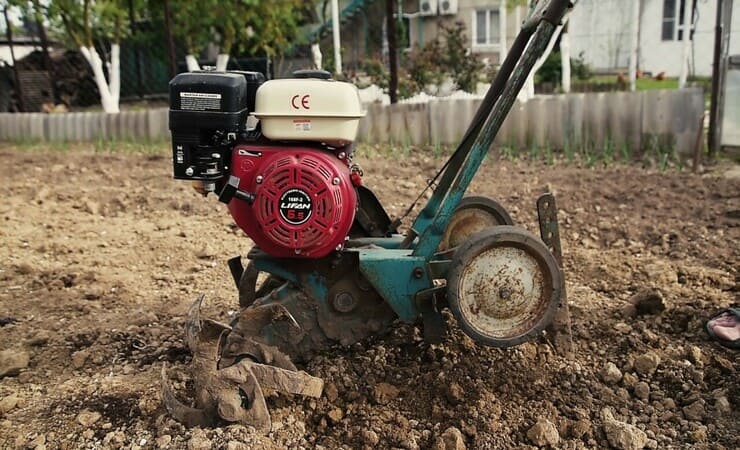
The Mole motor cultivator will help you fight weeds
There are several types of these machines:
- steam (for cultivating the land);
- row crops (for loosening the soil and controlling weeds);
- universal (for continuous and inter-row soil care);
- plant feeders (for maintaining the soil while simultaneously introducing minerals into the soil).
Common failures of motor cultivator components
The engine will not start
Ignition system
· The engine will not start;
· The engine, after working for some time, stalls and runs intermittently;
· The spark plug is faulty;
· The tip of the high voltage wire is not installed all the way to the spark plug;
· The high voltage electrical wire is broken;
· Magneto failure;
· The spark plug is dirty.
· Unscrew the spark plug and clean the electrodes, if necessary, replace the spare part with a new one;
· Check the connection of the high-voltage wire;
· Set up the ignition.
Important! If the above measures do not help eliminate ignition problems, and it is not clear which of the system components is faulty, then in this case it is necessary to replace the magneto.
Engine
· The engine does not start;
· The engine does not gain operating speed;
· Engine speed “floats” at the same position of the throttle control lever.
· Fuel does not enter the carburetor;
· The fuel supply hose is clogged;
· Carbon deposits have formed in the channels and cylinder head;
· Strong tension of the V-belt;
· The air filter is clogged;
· No compression.
· Blow with air, disassemble and clean the fuel supply system;
· Replace pistons, rings, cylinder;
· Check the cylinder head cover gasket for integrity and replace it if necessary.
Carburetor
- The engine starts and stalls almost immediately;
- The engine runs unevenly, with dips or interruptions, and often stalls;
- The engine will not start.
Causes:
- Incorrectly adjusted carburetor;
- The fuel filter or gasoline supply hose is clogged;
- The sprayer (“needle”) is clogged;
- The float does not block the access of fuel due to loss of tightness;
- The hole in the idle air passage is clogged.
We suggest you familiarize yourself with How to store horseradish in the cellar and at home - methods
Remedy:
- Adjust the carburetor;
- Disassemble the carburetor and clean or blow out all channels (jet jets), clean the sprayer (“needle”);
- Replace the float and fuel valve.
Gearbox
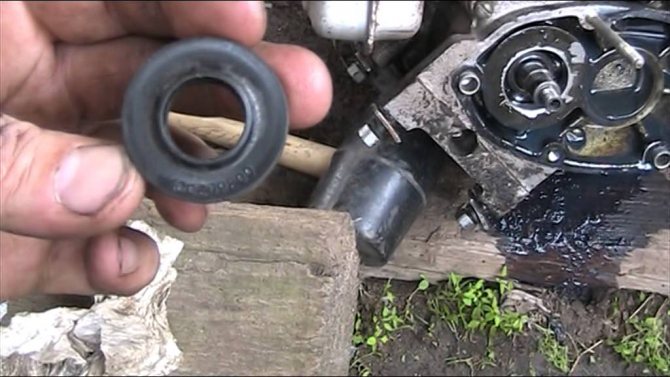
Gearbox
- The gearbox shaft rotates unevenly;
- The gearbox shaft does not rotate.
Causes:
- Low oil level in the gearbox;
- Loss of seal seals, dirt and soil getting inside the gearbox;
- Wear of gear sprocket teeth;
- Wear of bearing units;
- Gearbox circuit break.
Remedy:
- Disassembling and cleaning the gearbox;
- Changing the oil, monitoring its level while using the unit;
- Replacement of chain, sprockets and bearings when they are worn out.
Reverse
Description of the malfunction: reverse gear does not engage.
The reason is that the reverse gear was not adjusted during break-in.
Remedy: Adjust the reverse gear.
- The belt slips;
- The belt comes off the pulley.
Causes:
- The use of a non-standard, long-length belt;
- The belt has increased in length (stretched);
- The belt is not tensioned;
- The belt is on the wrong pulley.
Remedy:
- Tension the belt using a tension roller;
- Replace the stretched belt;
- Check that the belt is positioned correctly relative to the engine pulleys and attachments or trailed equipment.
Important! All the nuances of repair and maintenance, a detailed description of the design of the unit are contained in such a manual as “Operating Instructions for the Mole Motor-cultivator” - this is the technical passport of the product, which is necessarily supplied with it. Also included in the delivery package is a warranty card with a list of service centers and repair shops for this equipment.
Review of the model range of Mole motor cultivators
Mole MK-1
- Has low power (2.6 hp).
- Primitive device: engine (imperfect), gearbox, frame, handle, bracket.
In this video we will review the Mole motor cultivator:
Motor cultivator model Mole MK-1A
- Convenient, small in size and weight (only 48 kg).
- The ability to complement and expand the operational variations of this product.
- Reverse speed available.
Mole MK 3-A-3
- One axis.
- Quite light (approximately 45 kg).
Mole 3 DDE V 800 II
- Power – 7 hp
- The engine can withstand long periods of loads with low fuel consumption.
Mole MK 5-01
- Quite powerful Japanese Honda engine (4 hp).
- Also two gears.
Mole Subaru Robin
- Powerful Japanese engine (3.5 or 4.5 hp).
- Has two speeds.
Mole M
- The model with the smallest dimensions.
- There is a transport wheel.
- Honda engine.
- Lightweight (weight only 48 kg).
The Mole brand of walk-behind tractors offers many different models (from those that are cheaper to more expensive, respectively, with good, powerful parts for heavy, long-term work and a little simpler).
Mole Om
- The engine is two-stroke, carburetor.
- Has low power (2 hp).
- Engine capacity – 60 cm³.
- Quite a light device.
Technical characteristics of motor cultivators Mole MK-1A-01TS
- Small-sized agricultural machinery for shallow (25 cm) cultivation of the land, loosening it, leveling it, weeding rows, and so on.
- It has a small weight (approximately 45 kg).
- With the help of additional attachments, it can hill up, weed between rows, transport various materials, mow grass, etc.
- New improved parts provide reduced fuel consumption and reduced noise levels.
- Reverse gear available.
Mole MK-2
- Four-stroke engine (power – already 3.6 hp).
- Availability of two speeds.
- Improved chain reducer.
- Can handle difficult, hard ground.
Mole MK-9-01
- Four-stroke petrol engine, power (5.5 hp).
- Can treat areas up to 25 cm deep.
- Copes with the following jobs: digging, cultivating, loosening beds, leveling the ground, weeding rows.
- It has a highly reliable imported gearbox and a unique design of cutters (this motor cultivator can cultivate even the heaviest areas of land).
Mole 05-01
- It has a long-lasting gasoline engine of the Honda model (4 hp) with good balance.
- It can perform many functions (ploughing, weeding small gardens, processing clay soils).
- It has considerable weight (57 kg).
- A good chain reducer with low losses and long service life.
- Can move in reverse.
- Promptly cultivates large areas of land.
- Easy to use and learn.
Catalog of models and how much they cost
Motor cultivator MK-1A-02
The oldest and most reliable comrade who “will not spoil the furrows.” This motor cultivator is equipped with a two-stroke motor - simple and reliable.
Main technical features:
- gas tank volume: 1.8 l;
- cultivates an area width: 35, 60 cm;
- price: 19 thousand rubles.
Mole 1
Features of a reliable walk-behind tractor with an internal combustion engine:
- engine – 4-stroke, 1-cylinder engine with 6.5 hp. air-cooled;
- engine capacity model - GF 168 F-1 (GC200), 196 cm3;
- engine performance – 6.5 hp;
- gas tank volume: 3.6 l;
- oil tank volume – 0.60 l;
- cultivates an area with a width of 400-600 mm;
- treats the area to a depth of 150-250 mm;
- one gear, can only go straight;
- price: 20 thousand rubles.
MK-1A-01ts
This is a lightweight walk-behind tractor that runs on A-76, AI-80 and M-12TP oil.
Technical features:
- internal combustion engine: two-stroke, air-cooled;
- motor performance 5500-6500 rpm. – 1.9 kW, 2.6 hp;
- gas tank volume – 1.8 l;
- weight – 51 kg;
- The width during operation is: 130 x 81 x 106 cm;
- power during milling – 150-200 m2/hour;
- price: 15 thousand rubles.
This model is a single-axle motor cultivator.
Technical features:
- GoeTek motor with a performance of 3.5 hp;
- treats the area to a depth of up to 25 cm;
- treats an area with a width of 35, 60 cm;
- fuel tank volume - 1.8 l;
- can not only cultivate the area, but also level it;
- price: 10 thousand rubles.
Model M
This is the smallest model that the manufacturer presents. A transport wheel is located on the front part; this is the main difference between this model and other equipment.
Lawn mowers are actively used for processing both household and industrial plots. You can check out the best Stiga lawn mower models.
Kamaz 6520 is a reliable and efficient dump truck under any conditions and in any situation. all its technical characteristics are indicated.
The Caterpiler excavator is a modern special equipment of high quality. It can cope with any most complex technological task.
Milling heads are immediately attached to the “M” and are powered by a Honda engine.
Main parameters and dimensions:
- length 100-130cm;
- width 35-81cm
- height 71-106cm
- weight (without fuel) – 48 thousand grams;
- cutter diameter (rotor with knife), cm 32;
- two gears, can go forward and backward.
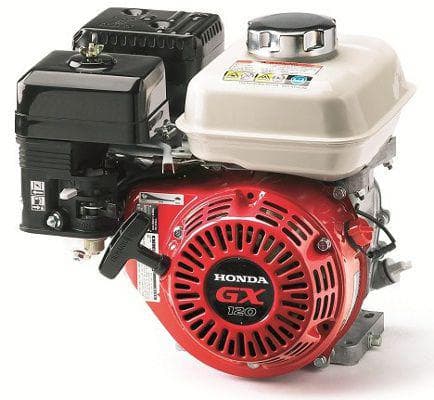
Technical features:
- Honda motor;
- internal combustion engine: four-stroke, air-cooled;
- engine volume 118 cm3;
- cylinder with diameter x per piston stroke 6 x 4 cm;
- maximum productivity 4l/s / 4000 rpm;
- maximum torque 0.75 N*m / 2,500 rpm;
- the model consumes fuel 230g/kWh;
- cultivates an area 35 or 60 cm wide;
- cutter with a diameter of 32 cm;
- one gear, can only go forward.
Technical features:
- motor 168F with a performance of 4.0 hp; operating in 4 strokes with air-type cooling, single-cylinder, valves located at the top;
- performance: at 3600 rpm. – 4 hp;
- motor power (h) 1100;
- scientific starter;
- engine volume (mm cubic): 1180;
- cooling parts, components and mechanisms with air;
- ignites thanks to the system: transistor magneto;
- gas tank volume (l.) 2.5;
- oil tank capacity (l): 0.6;
- one of the gears can only go forward, and the other in the opposite direction;
- cost: 21 thousand rubles.
Technical characteristics of this model:
- Hammermann engine, 5.5 hp, operating in 4 strokes, with one cylinder, valves located on top;
- performance: at 3600 rpm. – 5.5 hp;
- manual start;
- fuel consumption AI-92, AI-95: 395 g/kWh;
- cooling of parts, components and mechanisms with air;
- ignites thanks to a transistor magneto;
- parts of the crank mechanism move counterclockwise;
- uses oil for work: SF, SG, CEA 30, SAE 10B-40;
- gas tank (l.) 3.6;
- oil sump capacity (l): 0.6;
- cultivates area width (cm): 35, 60;
- one of the gears can only go forward, and the other in the opposite direction;
- price: 15 thousand rubles.
Technical features:
- engine (name): Robin-Subaru EU-15 D;
- performance (hp): 3.5;
- gas tank volume (l): 2.8;
- two gears, can go forward and backward;
- belt clutch, chain reducer;
- price: 26 thousand rubles.
This unit has a 4-stroke motor with one cylinder; the cooling system of parts, components and mechanisms occurs with a powerful air flow, there is forced circulation; There is an additional plate that protects against the scattering of earth.
This is the most purchased equipment, which has successfully proven itself to be the best. Initially - due to its reliability, but the two-stroke engine does not have enough performance. If we compare this model with the first one, then DDE 2, in addition, has a reverse gear, which makes the operator’s work easier.
V700II
Its main difference from other models is that the internal combustion engine used is of domestic rather than foreign production.
Do-it-yourself motor cultivator repair
The motor cultivator has the following components:
- Fuel system (carburetor, fuel tank, air filter and fuel supply hose).
- A starter (manual or electric), it is used to spin up the main shaft using a special cable.
- The cooling system operates under the influence of the rotation of the crankshaft and supplies cold air at flywheel speeds.
- The ignition system makes and supplies a spark in the design of the cultivator.
The sooner you understand where the breakdown is in your device, the faster you will fix it and repair it.
Most breakdowns occur due to motor failure. If this is indeed the case, then you need to check:
- Is this part heated, especially in winter?
- Is the air filter clean?
- Serviceability of the ignition system.
- Are all piston elements intact? You also need to check whether this part is installed correctly (fastening and location itself).
Fuel consumption of the cultivator Mole MK-1A
Also check out these articles
- Tractor MTZ 320.4 Belarus
- Combine harvester New Holland CR 9080
- Tractor MTZ-1221
- Insecticide Eforia
Economical fuel consumption is ensured through the use of a centrifugal crankshaft speed controller connected to the engine. This is also facilitated by a redesigned carburetor and air filter, as well as a reverse operating mode that provides reverse gear. In general, fuel consumption does not exceed 1 liter per hour of operation. The main type of fuel is low-octane gasoline A-76 mixed with MG-8A or M-12 TP oil. For ease of operation, the fuel tank capacity is limited to 1.8 liters.
What to do if the cultivator does not start
The reason for this may be the presence of old oil, and the symptoms may be the presence of white exhaust. In this case, the oil urgently needs to be replaced with a new one. Also, the cultivator may not start due to lack of oil in the fuel tank. Therefore, before using this unit, you need to check the amount of liquid in the tank. You also need to remember that each engine runs on a specific brand of fuel, and in order to refuel a two-stroke engine, you need to prepare a separate liquid (mix oil and gasoline in the proportions given in the technical descriptions and diagrams). It is also advisable to buy high-quality fuel at trusted gas stations.
